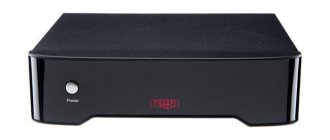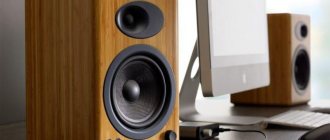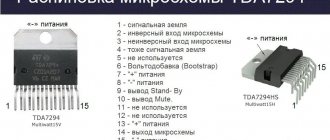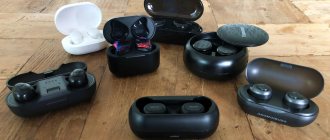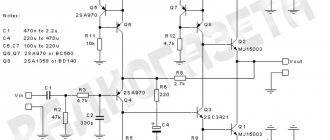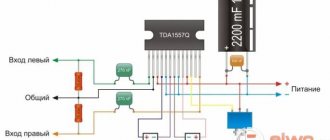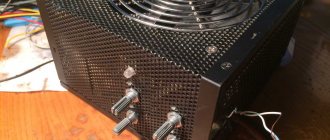In the second part of the test, I gradually moved from models considered very budget to models that are more expensive, but still fall into the low-end segment.
At the same time, the listening process itself and the result as a whole became more interesting, the MM section remained the main one during testing, but attention to the capabilities of the devices when working with MS heads was already more careful here. In addition, some models now have the ability to customize parameters for different heads. Otherwise, everything is as usual. The same running-in, listening and measurements. Let me remind you that although the test was divided into two parts, the testing itself was done at the same time and using the same path - this, of course, is a prerequisite.
Tonar Vinyline 4189 — 8000 rub.
Tonar Vinyline 4189 phono stage and external power supply.
The phono stage has a very simple and lightweight metal body. Outwardly, everything is simple and even a little brutal - black paint, inscriptions written in white paint, a bright red LED on the front panel, the only functions are switching between MM and MS modes. Everything inside is also very simple - a small board, very few parts and, of course, operational amplifiers. But there is one thing. The hardware is very similar in many ways to what I have seen in previously tested Pro-Ject phono stages. There are, of course, differences, these are clearly not copies, but it is still possible to assume an original origin from the same source. Much is very similar in terms of the circuit, and the installed parts, and even the size of the board, and absolutely identical input and output modules, located at the same distance. But the board material, installation, and power supply circuit are slightly different. In general, there is nothing completely unusual in this situation - Pro-Ject manufactures a lot of its own equipment and does something based on its circuits and develops for other manufacturers, besides, many of the tested devices can find some similarities. However, the origin of the circuit in our case is a secondary issue - what is more important is how everything is designed and assembled as a whole, as well as the immediate result in the form of sound.
The phono stage board takes up a very small part of the internal space of the case, and the circuit is very, very simple. Back panel. There is only input, output and switching of MM/MS operating modes.
The sound is rich, but not very bassy, a little sharp and assertive. The detail is moderate, the dynamics are closer to high. The presentation is strong due to a clear emphasis on the main tones and some blurring of the aftertones. The high frequencies are bright and piercing, but I won’t say that they were obviously tiring. The middle is quite flat and open. The bass is not the deepest, sharpest or most dynamic. The scene is wide, deep, airy and at the same time dense with images, but textures and nuances are lacking.
When working with an MC head, the sound is lighter and more mobile, not so assertive, and not lacking in brightness and expression. However, a simplified presentation of nuances and formality in presentation as a whole becomes noticeable. The picture turns out to be dynamic, airy, but rustic, and not all the strengths of even a relatively simple and inexpensive MS head can be revealed in this case. In some ways, this corrector turned out to be similar in sound to the tested Pro-Ject, but in some ways it is clearly different.
Thorens MM 005 — 9000 rub. Sympathy Prize
Thorens MM 005 phono stage and external power supply.
Externally, the phono preamplifier is not very different from others, but it has a heavy metal body, which is spoiled only by the overly bright and constantly glowing LED on the front panel. Everything is made carefully and at the same time modestly. The phono stage has quite decent connectors and a good remote power supply in the form of an adapter plug. There are several switches on the bottom to set the operating mode, but no other functions are provided. What may seem unusual is that to select between MM and MC you need to toggle four switches. Inside, everything is quite neat, but without any special revelations - a simple circuit using operational amplifiers, ordinary parts.
The moderately neatly mounted and not the most complex circuit is housed in a heavy case with thick walls. The rear panel houses the input and output jacks, and the MM/MC switches are located on the bottom of the phono stage.
The sound is moderately rich and fairly balanced. The bass is moderately voluminous, fast, accurate and correct. The mids are close to neutral, a little dry, the upper frequencies are dim. The scene is of medium width and depth, quite readable, with precise and correct proportions. The presentation is dynamic, but moderately detailed. The sound character is balanced and unobtrusive. Still, such a style is more suitable for bright tracts, and in tracts with a dull, unassertive sound, the picture may turn out to be less interesting.
When working with MC heads, no quality failure is noticeable; on the contrary, the character of the head is heard better than one might expect. Perhaps there is less bass in quantity, but the quality of the mid and high frequencies, and even the bass itself, is more correct and accurate. Higher detail and melody of delivery. The sound is both more cohesive and more detailed and legible. Also, the images and plans of the scene are more accurately developed; they are more subtly outlined and more textured. A certain simplification of the sound remains, but if this is applied to a path of the appropriate level, then the result is not bad. In terms of genres, this phono stage did not show any obvious features or preferences; even on complex, rich recordings, the decrease in dynamics and detail did not turn out to be critical. Although the formalization and slight simplification of timbres are more noticeable in the sound of acoustic instruments and vocals. However, with a successful combination with the tract, you can even listen to classical music.
Black Cube: review of Lehmann Black Cube, Decade and Linear D
The Hi-Fi Audio showroom takes a close look at the Lehmann Audio Black Cube and Decade phono preamplifiers, as well as the Linear D desktop headphone amplifier. Here are the main arguments from the new review, which you can read in its entirety at Hi-Fi Audio website. The first prototype of their Black Cube phono stage was born almost a quarter of a century ago - in 1995, and after some time the product achieved “cult” status among fans of vinyl sound. We ended up with a later (current) incarnation of Black Cube. It arrived in a simple, but moderately flashy and quite presentable cardboard package, decorated in the typical Lehmann Audio style with a gray and white color scheme. The device itself is made in a traditionally minimalist design, with a characteristically ascetic design - it is a black metal box made of non-magnetic material with a protruding ground terminal and a pair of input and a pair of output RCA connectors recessed into the body. Using a shielded cable built into the housing, the corrector unit is connected to an external power supply using a four-pin Neutrik XLR connector. On the bottom of the case there are four DIP switches for selecting a preset signal gain level. You can also select the type of cartridge and the level of required input impedance. The grounding terminal provides all connection options (bare wire, spade and banana). The circuitry uses new generation chips, Burr Brown OPA 13 operational amplifiers, high-quality components, and a passive RIAA equalizer. All this allows the device to work with almost any pickups. When listening with various types and models [of pickup heads] (Ortofon Quintet Bronze and 2M Black, as well as Audio Note IQ2), the device demonstrated considerable dynamics, high detail and emotional sound transmission - which once again became proof that external minimalism is far from always truly reflects the richness of inner content, which is sometimes more capable of attracting a true music connoisseur. Next in line was the “big brother” of the “Black Cube” - the Decade phono preamplifier. Packed in a white cardboard box with branding, it looks noticeably more impressive and mature in appearance (a clear evidence of this is the higher cost of the device!). The phono stage appeared on the market in 2005, on the tenth anniversary of the Black Cube, and occupied the price niche between it and the top Silver Cube. Similar to the “black cube”, Decade is packaged in austere metal, is outwardly modest and consists of two modules (corrector and power supply), connected to each other by a 4-pin removable XLR cable. The power supply has two outputs, which allows you to connect, in addition to the Decade itself, another corrector from the Black Cube line. The Decade uses a proprietary PWX II power supply, equipped with a 30-watt toroidal transformer. The topology of the corrector is built on the “dual mono” principle; there is a passive RIAA correction circuit based on precision elements. The gain is 66 dB, which allows the device to work with heads with low output signal levels. It also provides adjustment for load resistance and capacitance, which significantly expands the capabilities of the corrector when working with different types of heads. There is no general negative feedback in the device, and the Decade output stages operate in class A. There is a “rumble filter” switch on the front panel to protect the speakers from excessive bass. Next to it there are two switches for MM heads and MS (with a low input signal level), and a separate one for MS with a standard output level. In testing, Decade demonstrated a smooth, natural sound. He was able to create palpable emotional involvement while being highly detailed. Perhaps the only and very relative drawback of the device was the cost - because of it, it falls into the price category of phono stages, where there are many “budget” tube devices that can create considerable competition for it. The third device tested from Lemahnn Audio was the Linear D headphone amplifier. It was taken out of a package that was very reminiscent of that of the Black Cube, and made in the company’s traditional color scheme. The Linear D's design is largely reminiscent of the Decade: the same elongated, rectangular body shape, made of metal and equipped with vibration-absorbing SSC feet. On the front panel there is a volume control knob made with a dual variable resistor Alps. Two headphone outputs (Jack 6.3mm from Neutrik) are also located here. The device is powered by a high-quality toroidal transformer, providing a stable supply voltage and excess power to ensure dynamic range during playback. The circuit uses high-quality selected components and capacitors of significant capacity. The output stages of the amplifier operate in class A, thanks to which they cope perfectly with two pairs of headphones with the same impedance simultaneously. And there is no general negative feedback in his circuit. The internal circuitry is designed to provide the shortest signal path. There is a switch on the bottom of the case that allows you to change the Linear D gain from 0 dB to +10 dB, +18 dB or +20 dB. By the way, you can do this separately for each channel. The Lehmann Audio Linear D amplifier has a built-in DAC on the ESS Saber K2M chip, which allows the device to operate with a digital signal with a resolution of up to 24 bit/192 kHz. For this purpose, there are coaxial and optical inputs on the rear panel of the case. When two digital sources are connected simultaneously, the Toslink input is automatically selected, and if they are absent, the RCA analog input is activated. There is an adjustable analog RCA output with a resistance of 50 Ohms, allowing you to use this unit as a preamplifier. By the way, when you connect headphones, the line output located at the rear is turned off automatically. The power supply switch is located on the rear panel. Linear D is capable of working with almost any headphones, but during direct listening, the sound of the device in conjunction with the Audio-Technica ATH-W1000Z “closed” headphones turned out to be most preferable. The amplifier was also tested with Kennerton Vali and Sonus Faber Pryma 01 headphones. In general, the device copes with its function as an amplifier very confidently - it forms the proper sound dynamics with excellent detail and stage, while remaining quite neutral in sound character. To put it simply, it will ultimately depend on the headphone model you choose, while the Linear D will get the job done, delivering solid output control. After a close acquaintance with devices from Lemahnn Audio, you once again become imbued with sympathy for the German art of engineering, where words lead to deeds, and deeds lead to results. This definition also applies to our today's heroes, created with one sole purpose - to give naturalness and accuracy of sound, without being distracted by other relativity. And we can safely say that each of the tested Lemahnn Audio devices performs its task at a high level, meeting and sometimes exceeding expectations. Test – Evgeniy Pakhomov Editor – Dmitry Andreeshchev
Music Hall pa1.2 — 9700 rub.
Music Hall pa1.2 phono stage and external power supply.
The device is assembled in a small, neat metal case. The LED on the front panel doesn't look very good - it's so bright that you want to either cover it with something or remove the phono stage behind the components in the rack. Otherwise, the external design is very similar to those that I have seen in previous tested phono stages - one input, one output, a button that switches operating modes for MM or MC heads, and a remote power supply in the form of an adapter plug. Inside, everything is assembled on one board, and assembled more or less neatly. There is nothing unusual in the components, and the circuit is the same as in other cases on op-amps.
Neat assembly and circuitry, not fundamentally different from other tested devices. Back panel. We can say that everything is usual - signal connectors and a switch for various types of pickup heads.
The sound of this phono preamplifier is expressive and dynamic, with slightly emphasized high frequencies. The bass is a little loose and voluminous, the mids are rather warm and juicy. The high frequencies are bright, rich, but unsharp. The sound has good dynamics and detail, there is a clear volume, shimmering with many colors and shades. In terms of emotions and shades, everything is a little simplified, the presentation is rather joyfully upbeat. The stage is of medium width and depth, with dense, well-defined bright images. Everything is drawn with large strokes, but as such there is no rudeness or excessively annoying assertiveness. In terms of genre, there are some preferences for rock, pop and electronic music, while in classical music, in some cases, the sound lacks versatility and detail.
When working with the MS head, there is a noticeable increase in detail and greater cohesion and musicality, but at the same time expression, pressure disappear, and the presentation becomes lighter and more airy. In terms of transmitting the frequency range, the sound is smoother and more correct, but the emotional richness is smoothed out. The brightness is less noticeable, and the handwriting does not look as charismatic. Yes, perhaps the sound becomes smoother, but individuality is lost, which otherwise could be used in dull tracts with a depleted emotional presentation. The stage when working with the MS head is built more proportionally and correctly, but becomes clearly small and chamber-like. In this situation, of course, it is more logical to use the main character traits of the corrector in combination with a MM head.
Rega Fono MM — 12,400 rub.
Rega Fono MM phono stage and external power adapter.
The phono preamplifier has a larger housing than many in our test. Externally and functionally, everything is simple - one input, one output, an illuminated switch on the front panel. There are no settings; moreover, this device is designed only to work with MM heads. The phono preamplifier is supplied with a heavy external AC power supply - Rega PS-1; the same unit is equipped with junior Rega players. The circuit is assembled on one board, occupying the entire area of the case. The power supply and circuitry of the phono preamplifier itself are located on the board, and everything is mounted quite neatly. The circuit is more complex than many tested, even considering that this device only works with MM heads. But even here we couldn’t do without operational amplifiers.
The board occupies the entire case, the power supply and the corrector itself are separated, and the corrector circuit is more complex than many others. Back panel. There is nothing unusual here, only input and output connectors and a power supply socket.
The sound of the corrector is volumetrically airy, assertive and dynamic. The bass is not the deepest, but spacious and very rich. The middle is slightly raised and slightly warmer. There are a lot of high frequencies, but they don’t stand out from the overall picture - the whole sound is rich and rich. The handwriting is assertive and forceful. The detail is not the highest - after-sounds are masked by obvious accents on the main tones and fade into the background. Microdynamics, therefore, are not the highest, but macrodynamics - yes, everything is completely fine with it, and even more. The stage is wide, but not very deep, moderately airy and with a certain simplification of textures and flattening of images. In general, the handwriting is solid and memorable - you simply either like it or not. And if we take into account that this phono stage is supposed to be used in a system with low-end and mid-range Rega players and heads, then it should be noted that the character turns out to be very solid and recognizable. Genre-wise, the device gravitates towards not the heaviest rock, folk, blues, but complex recordings - progressive, complex electronics, large classical works sound somewhat weaker, since they want less of their own emotional coloring of the tract, higher detail and accuracy of transmission of timbral shades.
Test report Lehmann Audio Black Cube Linear USB Out 1
General test results
General test results of Lehmann Audio Black Cube Linear USB Out 1
Channel
general*
Frequency response unevenness in the range 40 Hz 15 kHz, dB
-0,19, +0,03
Output impedance average in the range 40 Hz 15 kHz, Ohm
5,8
Maximum voltage level without load, V (rms)
N/A
Maximum power level obtained under load N/A Ohm, mW
N/A
Detailed description of technical characteristics in the table »
Calculate the SPL of headphones with an amplifier Lehmann Audio Black Cube Linear USB Out 1 in an online calculator based on the data in the table »
The table shows the main, most important technical characteristics of Lehmann Audio Black Cube Linear USB Out 1
Contents of the measurement report
Main results of testing the frequency response of the amplifier under resistive loads Frequency response of the amplifier under load of the dynamic type Deviation of the frequency response of the amplifier under load of the dynamic type Frequency response of the amplifier under load of the armature type (single-driver) Deviation of the frequency response of an amplifier under load of an armature type (single-driver)
Clearaudio Nano Phono - RUB 15,000. Test winner.
Clearaudio Nano Phono preamplifier and external power supply.
The device is quite small in size, practically the smallest of all tested. But at the same time one of the cutest in appearance. The phono preamplifier has an all-aluminium, high-quality machined body and a remote power supply. Functionally, this device is very unusual. Judging by the location of the input and output, the internal circuit is designed according to the dual mono principle. In addition to switching the MM/MS modes (carried out using jumpers), you can select the required resistance for the MS heads. To do this, you need to select a suitable resistance from the supplied set and insert it into the phono stage. You can take resistors not only from the kit, but also use any ones, both by nominal value and by manufacturer (this is convenient and gives a lot of additional possibilities). Plus, the phono stage has an output control, which allows you to use it without a preamplifier in some cases. But it was not possible to study how everything was implemented in detail - the body of the device is non-separable. All that's left is to listen.
It was not possible to look inside the case - it is not dismountable. On the bottom there are MM/MS switches and places for connecting resistors. The body of the device is very small; there is barely enough space for connectors on the rear panel.
Very good dynamics are immediately noticeable in the sound, detail is clearly higher than the statistical average. The presentation is rather cool, analytical, sometimes harsh, but overall quite realistic. There is practically no feeling of blurriness or smoothness. The bass is moderately deep, punchy and textured. The mids and highs are neutral-smooth and not bright, but the highs are sometimes a little sharper than necessary. The sound, with all its features, is light and tireless, unless you combine this phono preamplifier with an overly bright and caustic-sounding circuit. The stage is wide and deep, but there is no heaviness in it, everything is light, fast and moving. The images are well defined and do not merge at all. When working with the MS head, the result is also very good. Dynamics and detail are preserved, the sound becomes more elegant and rich in shades, but the style as a whole remains the same. There were no genre preferences for this device - all recordings sounded at approximately the same level, without obvious preferences or failures. Considering that this is still a very inexpensive device, the results turned out to be very good both in themselves and in comparison with other subjects.
Add a link to a discussion of the article on the forum
RadioKot >Schemes >Audio >Amplifiers >
| Article tags: | Add a tag |
Excellent quality at low cost. Lehmann Black Cube Linear Light.
Author: STRIKER_ZT_UA, Published 03/16/2016 Created with the help of KotoEd.
Introduction. Having found TDS-5 headphones in some bins, I was very happy. A good find for a novice connoisseur of quality music. True orthodynamics. But there is also a small pitfall: they have too little sensitivity. I used them for several weeks directly from the linear output of the sound card. But she couldn’t unlock the potential of these headphones alone. I constantly wanted to turn up the volume. And then I firmly decided that I needed to make an amplifier. High quality amplifier. While looking through a bunch of forums, links, topics, I came across a diagram of a famous amplifier from Lehmann. He managed to earn respect and popularity for his simplicity, quality and accuracy. And the cost of components for its self-assembly is less compared to the price tag of a ready-made branded amplifier. Several dozen times. I decided to collect it.
Circuit design.
The amplifier circuit is no different from the original, except for the method of implementing the OOS. In the original, only the op-amp is covered by it, and the output stage operates without OOS. However, for the sake of reliability, I decided to cover all stages of the general OOS for the accuracy of setting 0 at the output and to reduce the CG of the output stage. The gain is calculated using the formula Kus=(1+R4/R3) . The VC quiescent current is close to 60-70 mA per channel and it is changed by resistors R7/R8, provided R7=R8 and inversely. This means that the amplifier operates in full class A. At the same time, a sufficient amount of heat is dissipated on the transistors of the output stage. Radiators are a must! Don't forget about the variation in component parameters. It should be as small as possible. To do this, I sorted all the transistors and resistors back in the radio store. Try to select the highest quality components . I selected the transistors in the circuit based on accessibility criteria. You can even safely install analogues. For example, the complementary pair VK KT814/815 can be replaced with BD139/140, it will be a little better. What about the OU - here who can afford what. But be sure to place a panel under it . I personally installed the NE5532, but you can also install the cheap TL072 or the audiophile OPA2132/34. You can feel the difference in comparison, but that’s another topic. Capacitor C2 is optional - it helps the op-amp to more accurately set 0 at the output. If you install a high-quality “sound” capacitor, this is an ideal option. Although, as they say, the fewer capacitors in the sound path, the better. Here you can experiment. Capacitor C3 - fights excitement, if any . There is no volume control resistor on the circuit and the PCB. I think you know how to connect it. I chose a simple dual linear imported variable resistor with a nominal value of 100 kOhm. You can also install Alps.
The power supply is simple - two parametric linear stabilizers for each arm, several electrolytes and films. All this stuff is powered from a transformer with two windings with a midpoint . The ideal option would be a torus, but you can also use an W-shaped one. Its output voltage can range from 2x12 to 2x24 volts. It’s not worth raising it above 2x15, because... The stabilizers are linear and they will have to install larger radiators. But if dimensions allow, then it’s possible. A surge protector is welcome . It protects against “clicks” when turning the amplifier on and off, and will also prevent high-frequency network interference from causing any trouble. And don't forget about the fuse! .
The general view and arrangement of parts on the printed circuit board is shown in the photo below.
The connection point for the indicator LED is noticeable. The polarity, dimensions and pinout of some imported and domestic elements are taken into account. Don't get confused! There are jumpers! Assembly.
During operation, I decided to make an additional gain switch and two parallel-connected 3.5 mm output jacks for simultaneous connection of two pairs of headphones or acoustics. The gain switch is a double toggle switch, half per channel, which connects or disconnects additional resistance in parallel with resistor R4 OOS, changing the gain accordingly. It matches the output level to the input level for convenient and uniform control via the volume control. For the TDS-5 headphones, I chose the Kus at level 10. For the rest of the headphones, by switching the toggle switch and connecting a 4kOhm resistor in parallel with R4, the Kus becomes equal to 3. The housing is the most important problem of any craft, isn’t it? In my case, I made a drawing of the body and assembled it from 8-ply plywood. Spray coated with three layers of varnish and stain. Front panel made of pure aluminum. Of course, duralumin would be better, it doesn’t oxidize like that. The back panel is made of non-foil fiberglass painted black. I took gold-plated RCA input connectors so that they would not oxidize. I took the power cord, its connector and the switch from a non-working computer power supply. I was generally lucky with the handle for the volume control - the inner diameter is ideal for imported variable resistors. I took it out of an old reel-to-reel tape recorder. I don’t remember which one exactly. The top cover is made of the same, and also painted black from a spray can. The decorative hole for the indicator and the LED itself were purchased at a radio parts store. All signal circuits are switched using only shielded copper wire with a star connection to the ground, in order to avoid the formation of ground loops.
Here are some photos:
Inside:
Here is the hero of this celebration:
Enhancer in natural and everyday environment for several weeks:
Conclusion:
The result is a high-quality, universal amplifier. Not capricious in assembly and adjustment. It can be used both for monitoring and for simply enjoying music that begins to sound different. I began to notice small details, rustling sounds in the reproduction. I started downloading records only in Flac format. I had to listen to my entire collection again. Pink-Floyd, Dire Straits, Rolling Stones, Metallica - they sound completely new. I advise everyone who is starting their journey into the world of high-quality sound to collect it.
Files:
Printed circuit board
All questions in the Forum.
| What do you think of this article? | Did this device work for you? | |
| 40 | 11 | 7 |
| 0 | 0 |
Vincent PHO-8 — 17,000 rub.
The Vincent PHO-8 phono preamplifier and external power supply are assembled in identically sized housings.
The first and only phono stage in our test that has a full-size power supply. The device is assembled in two identical cases, in one there is a DC power supply, in the second there is the corrector itself. The blocks are heavy, but primarily due to the thickness of the walls of the buildings themselves, which, in principle, is not bad. The device does not have any settings, only switching between MM/MS operating modes. There is also a switch and unobtrusive LED indication. Inside, everything is assembled quite neatly, a little more attention is actually paid to the power supply than in other correctors, the circuit may use operational amplifiers, but it itself is not primitive, and everything is assembled with high quality, using standard, mostly high-quality parts.
The power supply and corrector are separated and assembled in separate housings. The phono stage circuit is not that simple. Rear panels. Everything here is the same as everyone else's - signal connectors and power connectors. Unless it is connected to the power supply using a special wire and a connector for the power cable.
The sound of the device is rich, biting, with a slight emphasis on the upper frequencies. The bass is quite thick, assertive, but not harsh. The middle is transparent and movable. There are slightly more high frequencies than necessary, but within acceptable limits, without obvious harshness. The dynamics are rather closer to high, and the detail is not bad. The presentation is both emotional and coherent, without being sloppy or bloated. The stage is wider than average, deep, with good proportions, airy and moving. There is no overkill or lightness, the sound is perky and confident.
With an MC head, the sound turns out to be more cohesive and at the same time less stable, there is a slight uncertainty and simplicity, a little lack of pressure and emotion. At the same time, the detail is higher, more shades, textures and emotional transitions are heard in the sound, the emphasis on the upper frequencies becomes almost unnoticeable, and the sound throughout the entire range is more even - after all, this corrector can reveal some of the strengths of MC heads. But the scene becomes more intimate and more lightweight - there is more air, but the images are not drawn so clearly, which, combined with less saturation, creates a feeling of lightness. In terms of genres and recordings, this phono preamplifier is rather universal, unless you listen to complex orchestral or choral works, on these recordings you can hear a lack of detail and may also lack detail in the display of the scene. Otherwise, the results are generally more confident and smooth.

